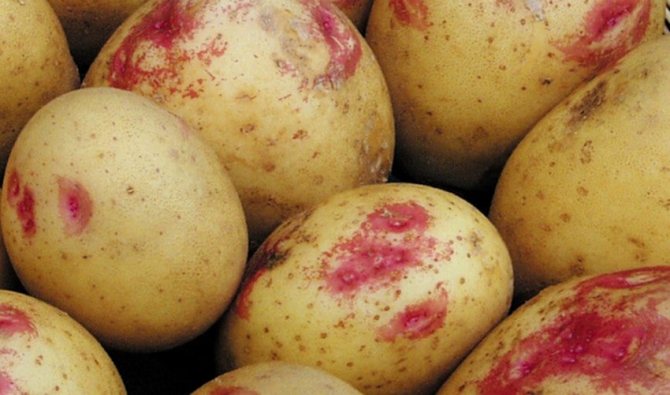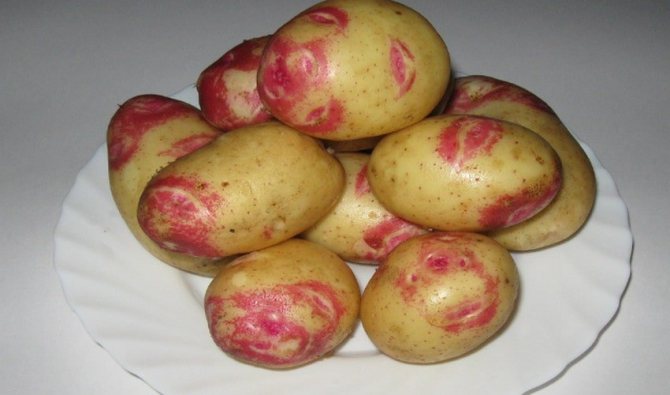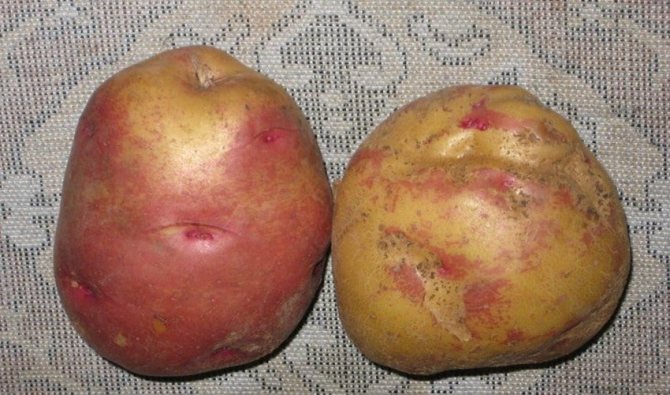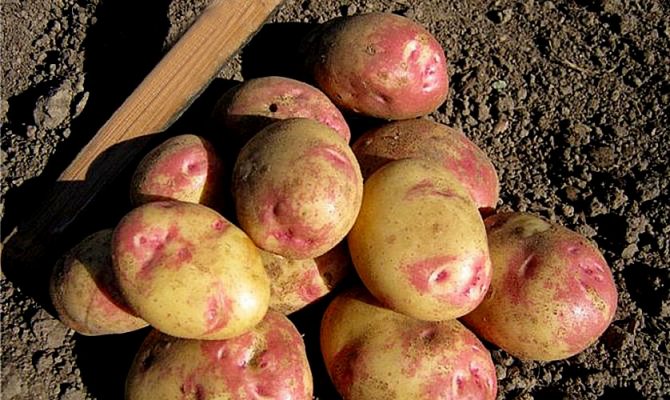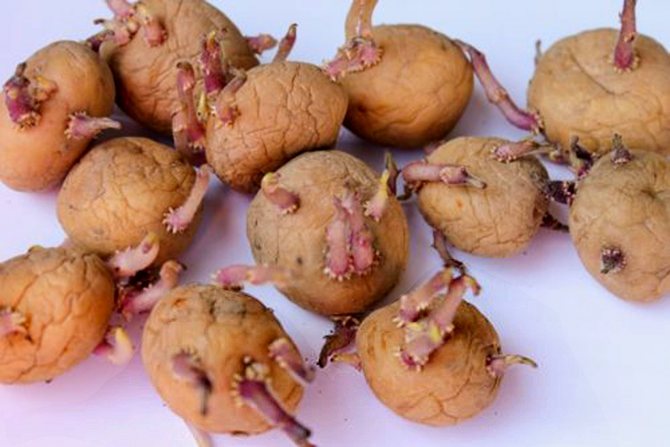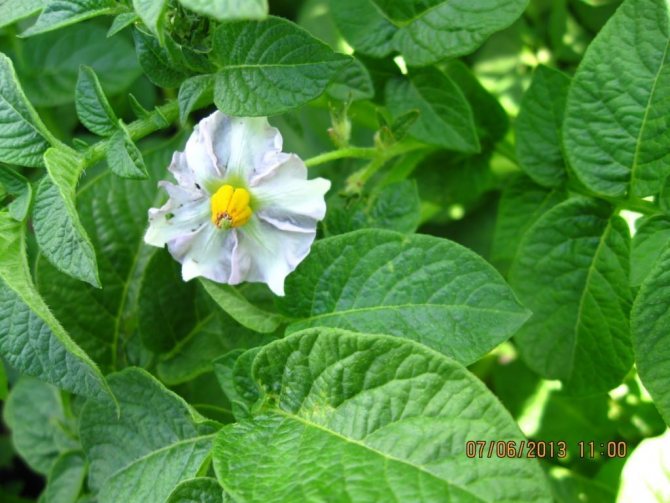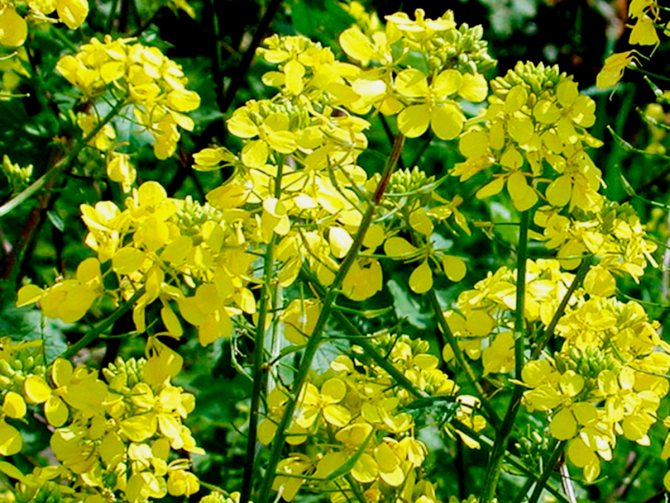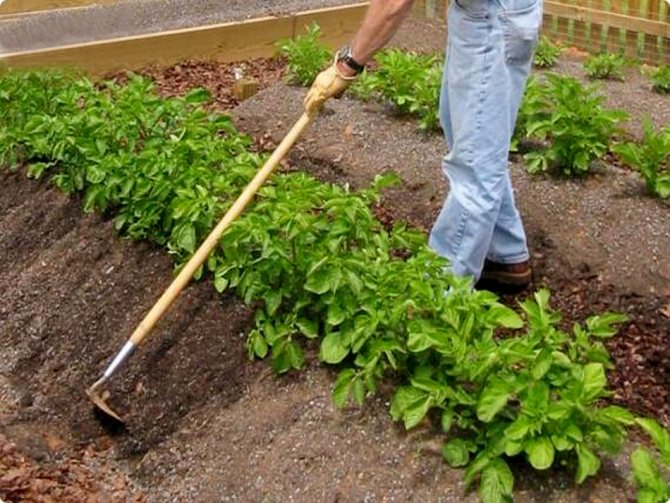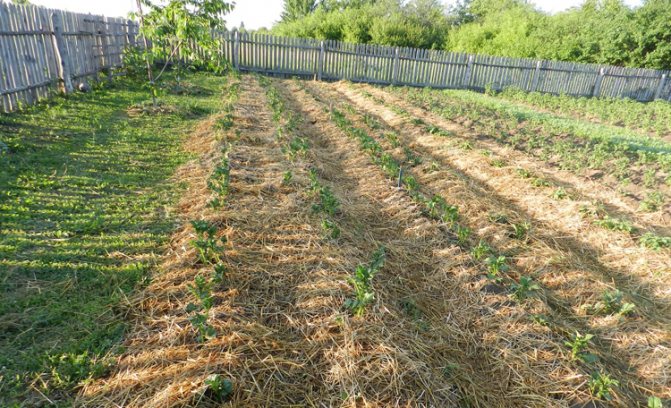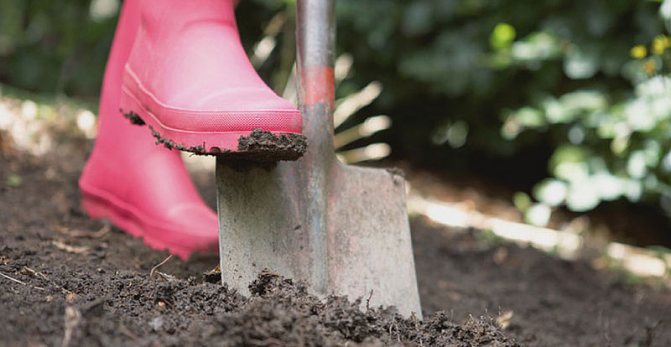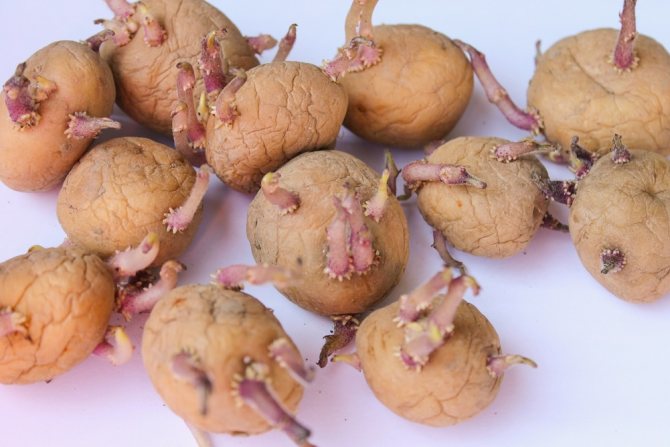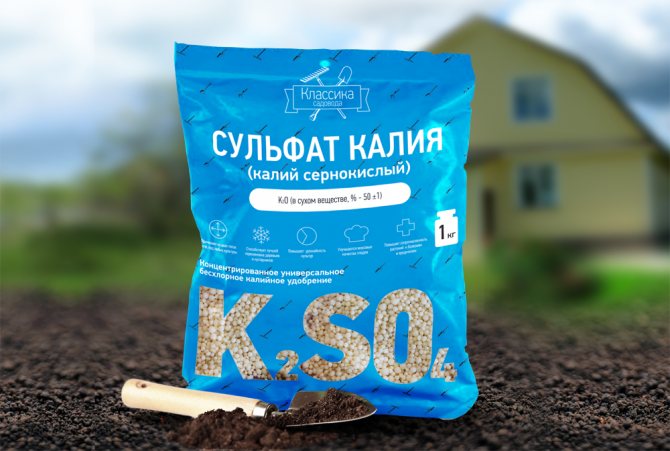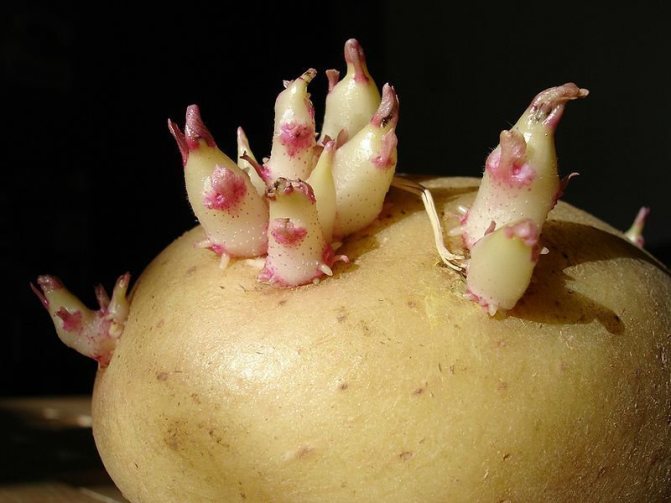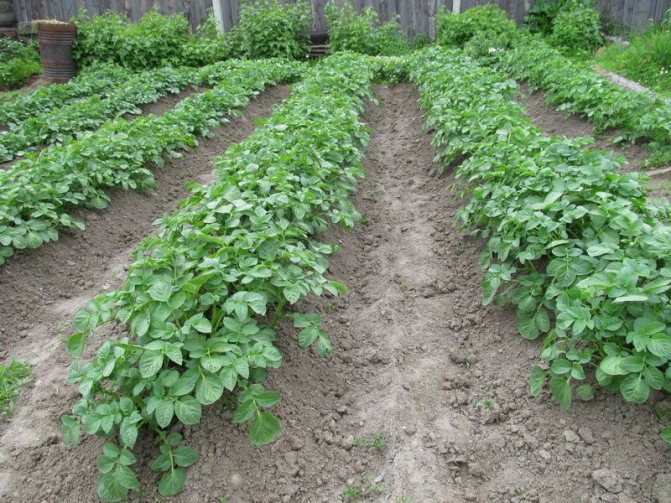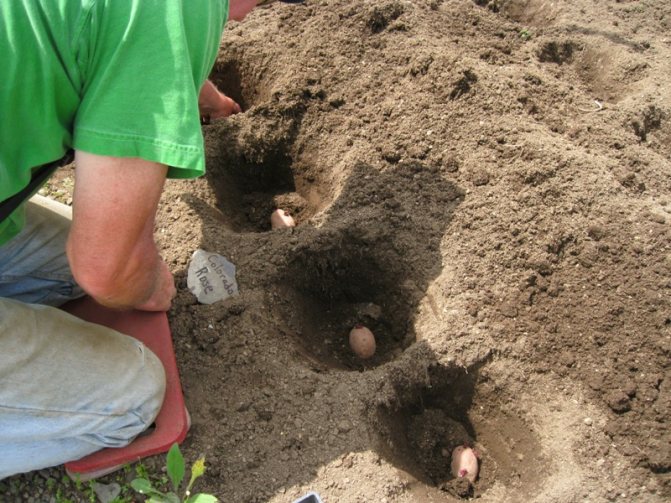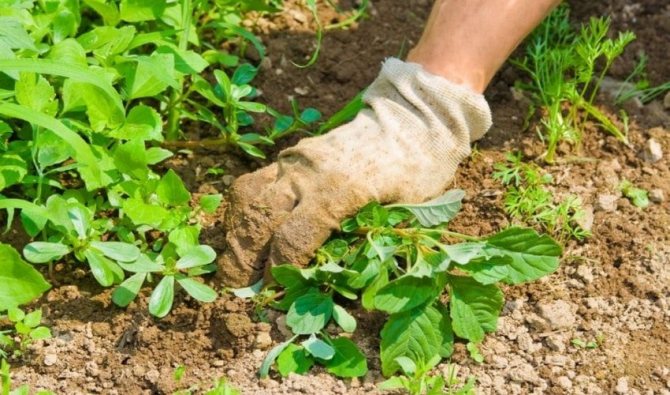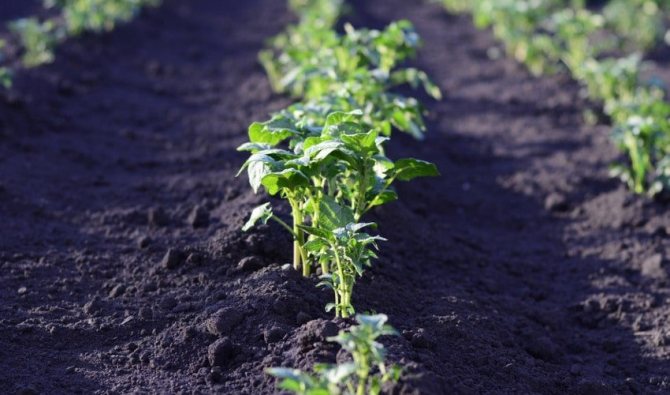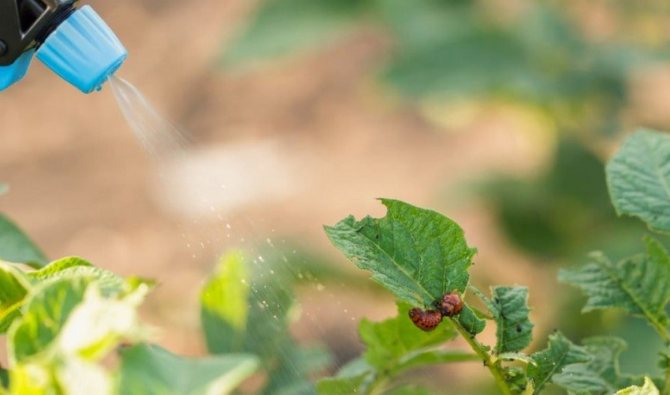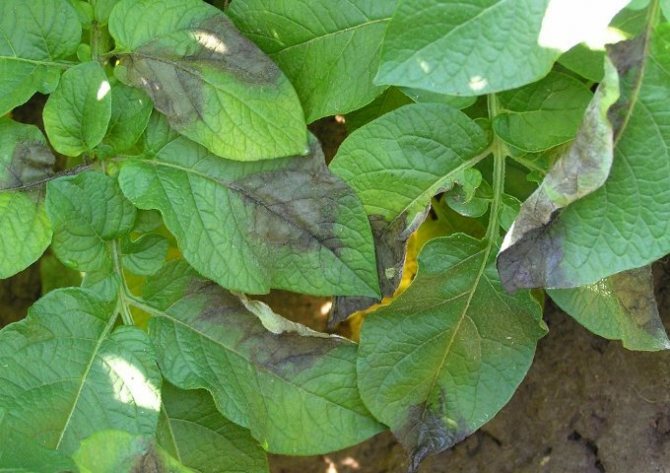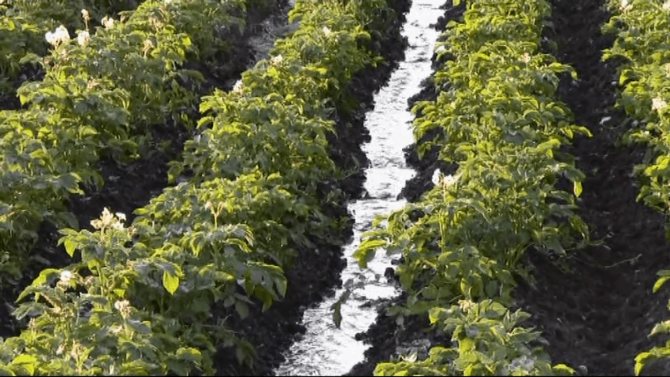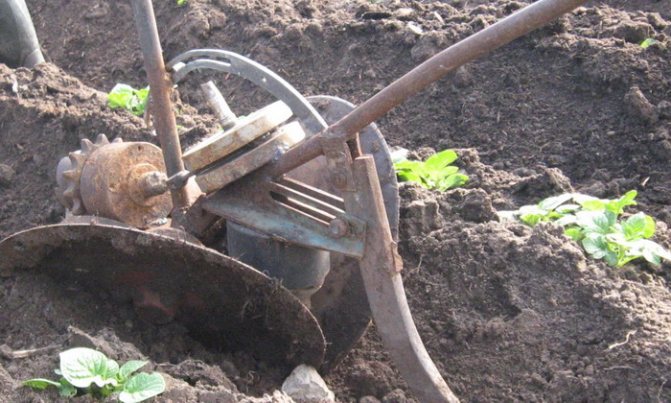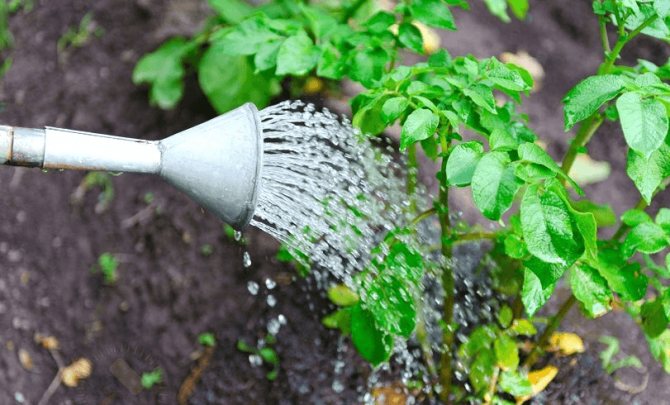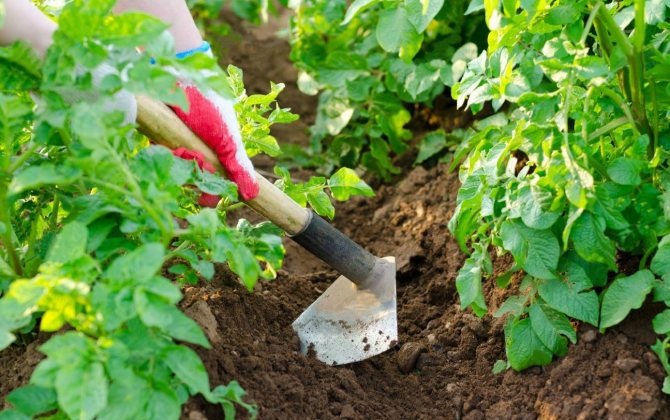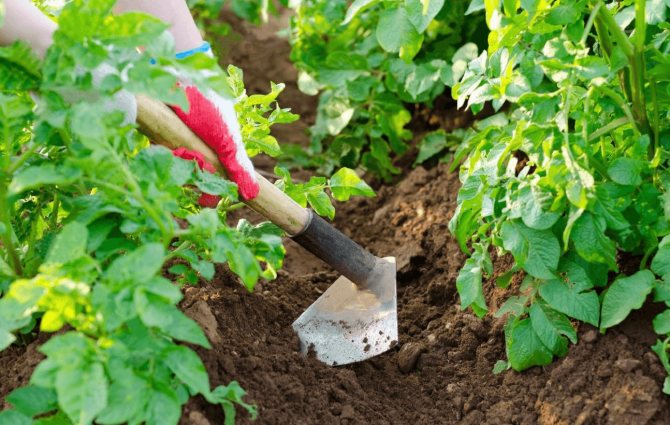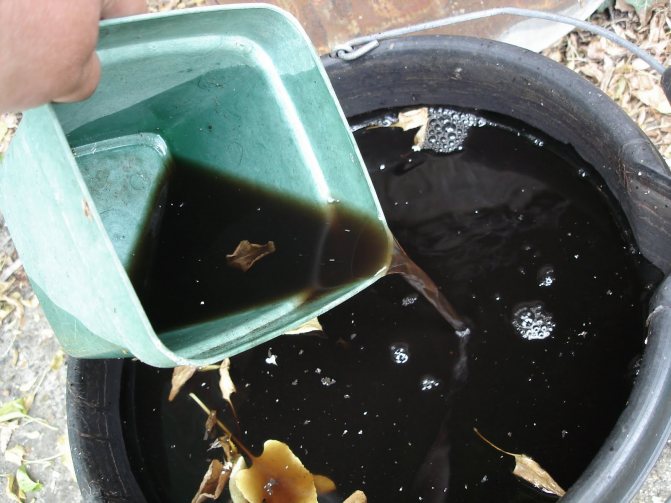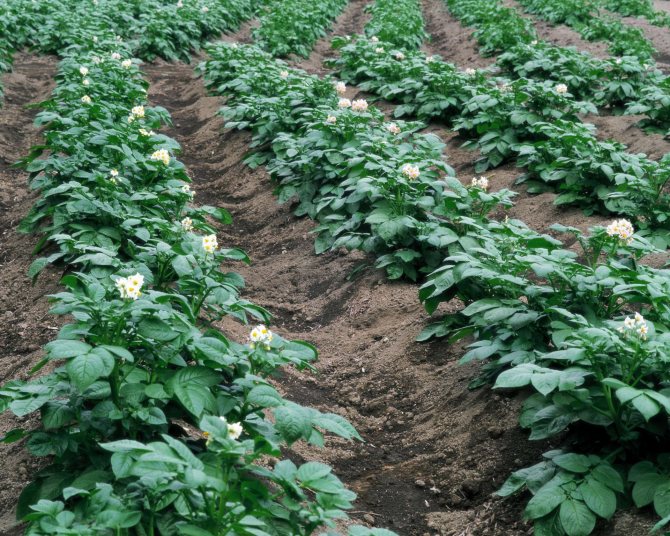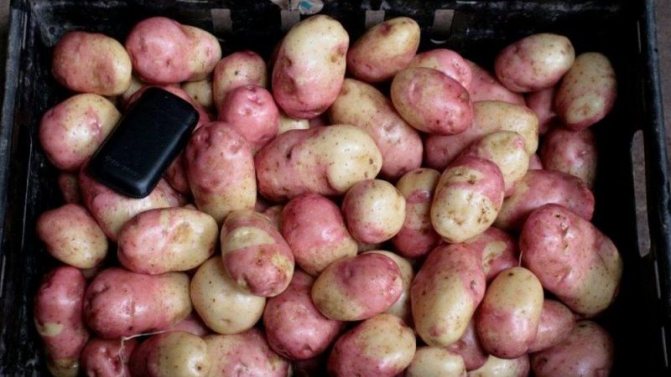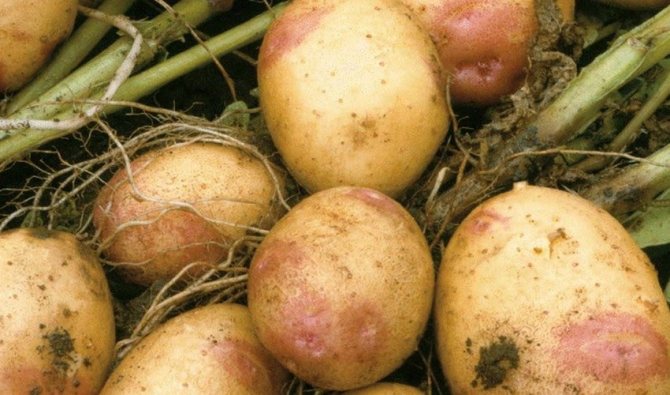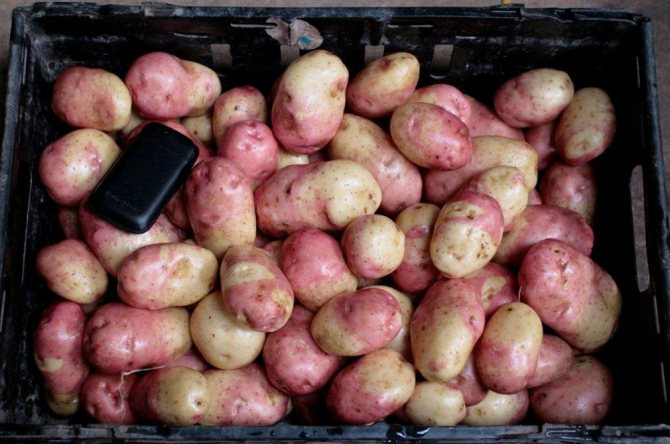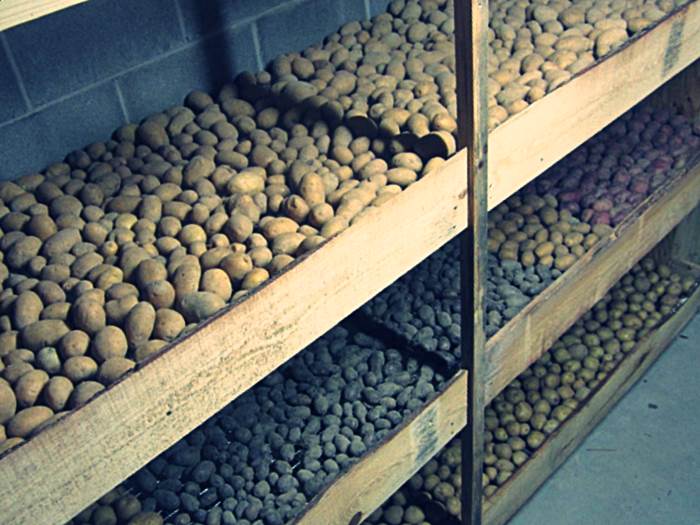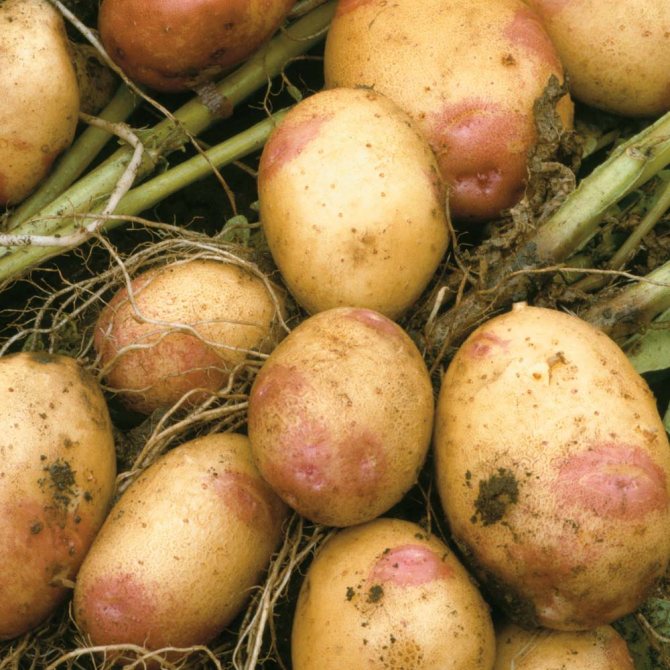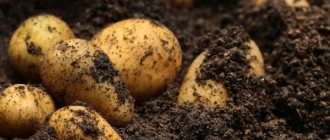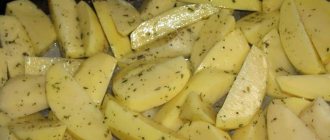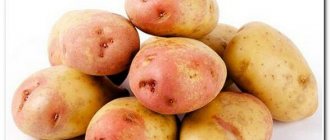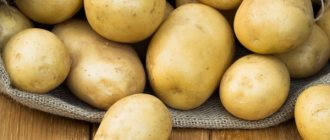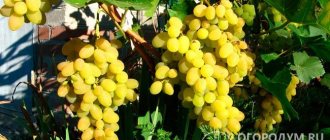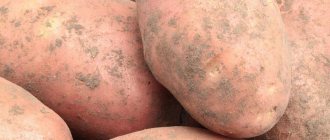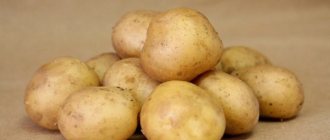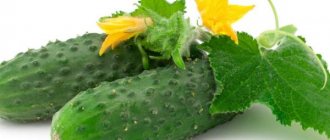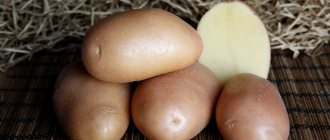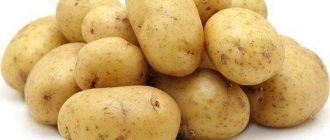Sometimes foreign plant varieties take root in our country so that the name of the progenitor variety is relegated to the background, and the names of the variety given to it at the place of cultivation are widespread. This happened with the Picasso potato variety. Spontaneous folk selection of this variety led to the emergence of its many clones, of which Ivan da Marya is most heard.
- Description and characteristics of the variety
Advantages and disadvantages of the variety, table
- Preparing tubers for planting
Planting potatoes, video
- Care of potatoes after planting, table
- Diseases and pests of the variety, table
Fighting the Colorado potato beetle, video
A descendant of Picasso, or a brief history of the Ivan da Marya variety
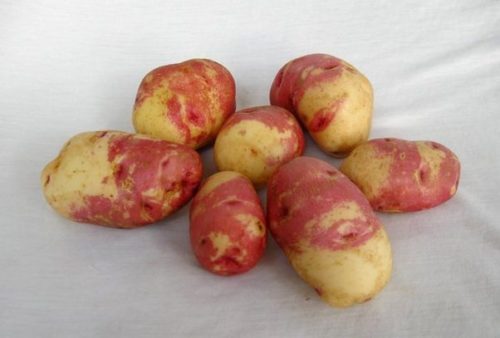
Ivan da Marya is an interesting variety, famous for its unique appearance
Ivan da Marya is the popular name for a variety of Dutch selection with medium early ripening times for Picasso. In 1995, it was entered in the State Register. Has many alternative names. Since this potato gained popularity during the reign of M.S.Gorbachev, it is known as Gorbachevka.
Ivan da Marya potatoes are a descendant of the Dutch Picasso variety (created by AGRICO U.A.). He came to our country during the years of perestroika. Folk selection has led to the appearance of varieties similar to the Dutchman, the most famous of which is Ivan da Marya. But it is under the name Picasso that the variety is included in the Russian State Register of Breeding Achievements. They began to cultivate it in the Central region. In addition, it spread throughout the European zone.
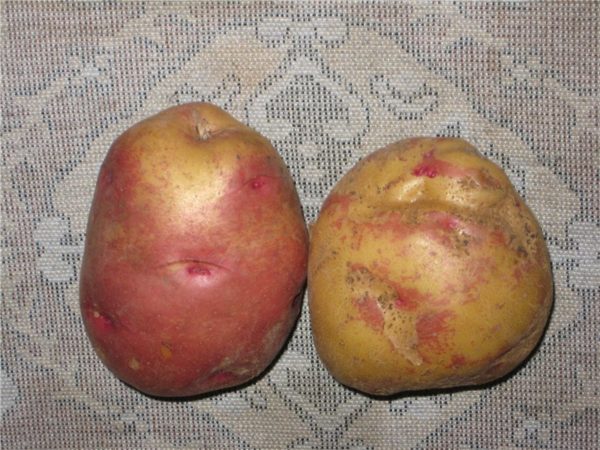

Potato tubers Ivan da Marya have a peculiar look
Advantages and disadvantages
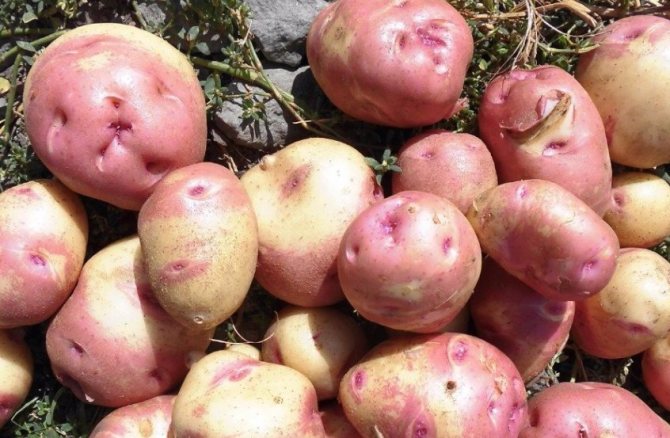

Ivan da Marya is high-yielding. The average rate is 200-320 c / ha. The maximum yield was achieved in the Central, Southern regions of the country through timely fertilizing, watering, and loosening. Climate plays an important role.
Benefits:
- It has strong immunity to almost all diseases, it is not afraid of late blight, potato cancer, A and Yn viruses, leaf rolling.
- Unusual tubers attract the attention of buyers, respectively, sales rise.
- Good taste.
- The presentation is excellent, because all fruits are of the same weight and shape.
- Drought tolerance ensures good yields in arid southern regions.
Disadvantages:
- weak immunity to scab;
- the plant is susceptible to Colorado potato beetles;
- tends to degenerate quickly, so it is important to change seed frequently.
Reviews of gardeners about the taste and other characteristics of this potato variety
Ivan da Marya is an unpretentious variety that is grown in various climatic zones. It is also undemanding to the type of soil. The yield of this potato is quite high, but regular maintenance can improve the fruiting rates.
Ivan da Marya belongs to the late-ripening varieties. Its ripening time varies from 110 to 130 days (depending on weather conditions). The potato yield is high. One bush gives up to twenty tubers, the average weight of which is 120 g.More than 90% of the obtained harvest is marketable root crops. From one hundred square meters they collect from 320 kg of potatoes.
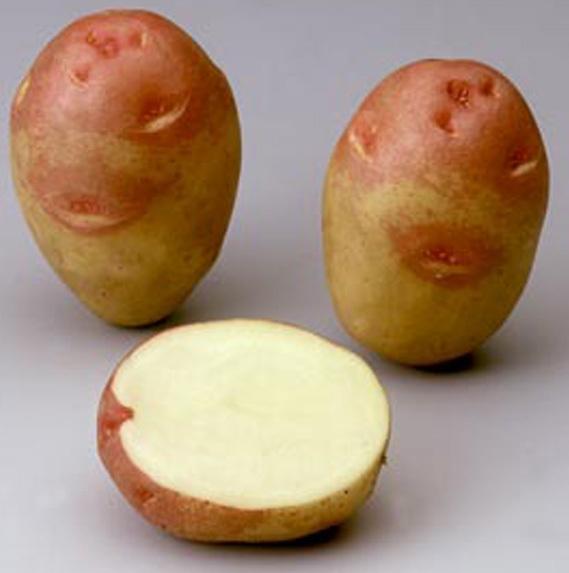

Ivan da Marya potatoes ripen 120 days after planting
The bush is erect, tall, but not spreading. With abundant watering, the branches can bend to the ground. Blooms in small white flowers, not collected in a brush. The color of the petals ranges from cream to lilac.
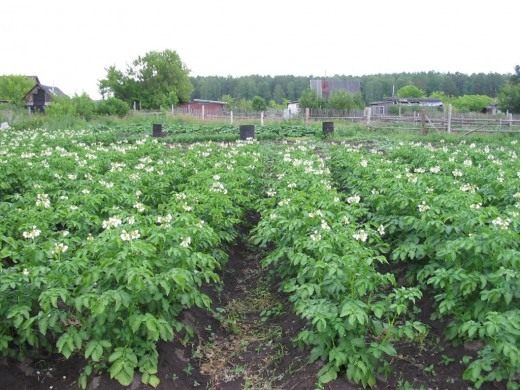

The flowering of potatoes Ivan da Marya happens together
Root crops of the variety are distinguished by a peculiar color: yellow with pink spots. The eyes are small, reddish. The tubers have an elongated oval shape. The cut fruits reveal a milky flesh (it is pinkish just under the skin).
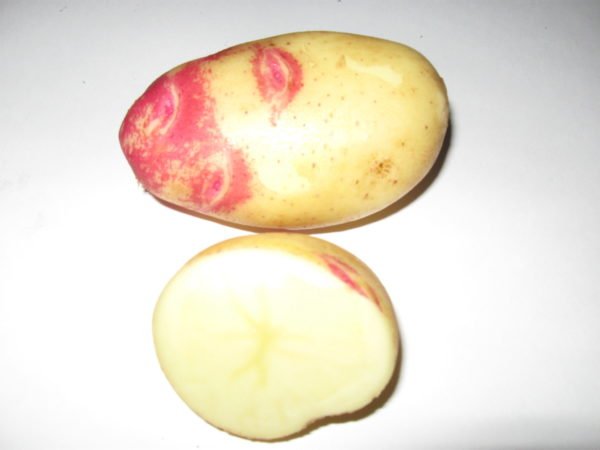

The appearance of the tuber is attractive, inside is white pulp
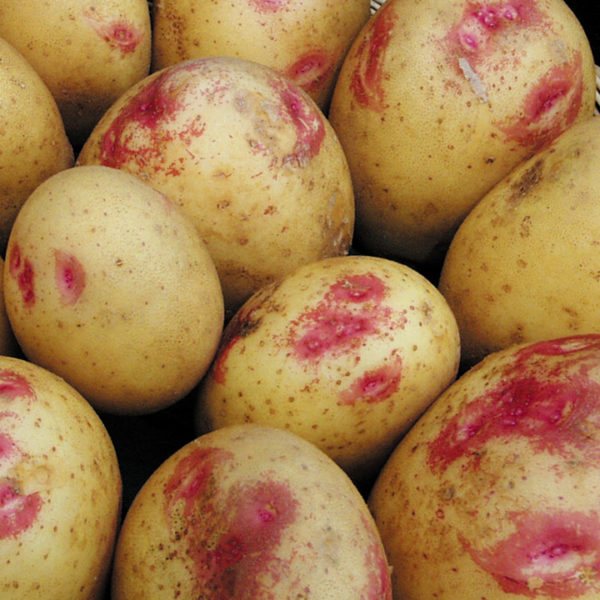

Observing the rules of agricultural technology, you can achieve a high yield of the Ivan da Marya variety.
Potatoes of any variety prefer sunny areas with light sandy soil.
Young mustard is not afraid of the first frost and continues to build up its green mass until the onset of severe frosts
When planting, throw a few handfuls of soil from the compost pit into each hole. Ivan da Marya gives a good harvest on acidic soils - which is very important for the variety, since scab (fungal disease) does not develop in this environment. But it is worth considering that such land is the habitat of the wireworm, which pretty much spoils the tubers, eating whole canals into them.
The tubers are prepared for planting in mid-March - early April.
- The potatoes are taken out of the cellar and left warm for several days.
- Further, the fruits are revised, long shoots are removed (they will not make strong shoots, since they spent a lot of effort on germination in a dark and cold room).
Long thin shoots should be removed - Then the planting material is laid out in one layer in a bright room at a temperature of 15-18 ° C for 12-16 days. The sprouts will appear faster and the tuber itself will turn green. Such potatoes are less affected by the Colorado potato beetle.
Potatoes with strong, short sprouts will sprout faster - Before planting for disinfection, the tubers are dipped in a weak solution of potassium permanganate (it should be pale pink).
A good guideline for planting Ivan da Marya is a simple birch - the time when leaves appear on it is considered the best for planting potatoes.
When planting, a distance of 40 cm is left between the plants. The aisles should be 60 cm each. For potatoes, dig holes on half a shovel bayonet, put the fruit and sprinkle it with earth.
For potatoes, dig holes for half a shovel bayonet
Features of the
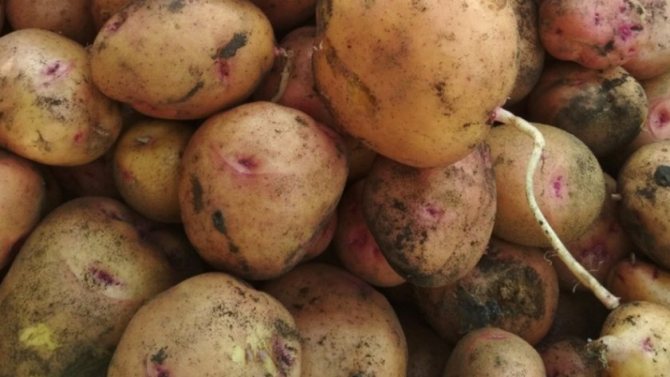

Interestingly, very often the name of this potato depends on where it grows. Distributed. In the Stavropol region, they call him Ryabukha, and in Kirov, they call him "Fox" or, from him, Lyska.
The unusual appearance is complemented by a number of other features:
- high productivity;
- boiled well during heat treatment;
- each plant bears very many fruits;
- very good keeping quality, respectively, potato sales are high;
- average or late boarding time;
- prefers acidified soil type;
- has a stable immunity to A, Yn viruses.
The stems of the bush are tall, straight, have a large number of leaves, can be inclined to the ground. The leaves are very large, rich green color. The buds are most often white, sometimes creamy. The plant blooms profusely, at the stage of budding all inflorescences fall off.
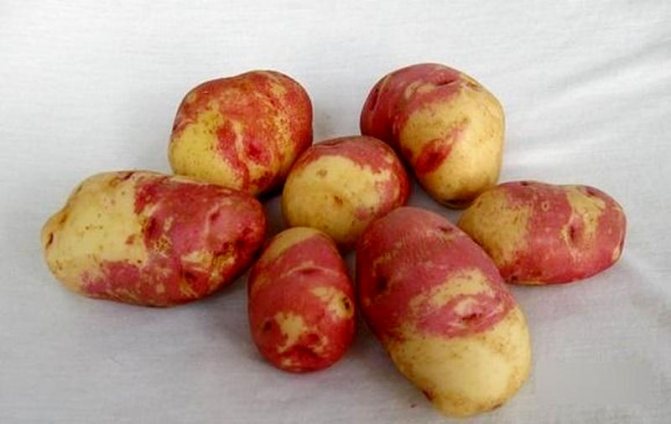

Note!
The tubers are streamlined, round-oval in shape, the skin is thin, of an unusual beige, bright burgundy color, which is of interest to buyers. The eyes are small, pale pink.
The starch concentration in the fruit is average, from 8 to 14%. Ivan da Marya belongs to the group of high-yielding species, so it is possible to collect many fruits from each bush, about 15–25.
The ripening time after the first shoots is 110–120 days. The average weight of fruits is about 90-120 grams. The size will vary due to different climates, frequency of feeding and watering. The pulp is tender, creamy. The keeping quality of potato tubers is high - 90%, marketability - more than 93%, which cannot but please the sellers.
Planting "festival" potatoes
To grow any crop and get a high yield, certain rules are required.
For planting potatoes, only perfectly healthy planting material is suitable. The seed tubers should be free from damage, cracks, rot, scab or pest marks. It is advisable to treat the seed potatoes with special means. One of the options is Agat-25K.
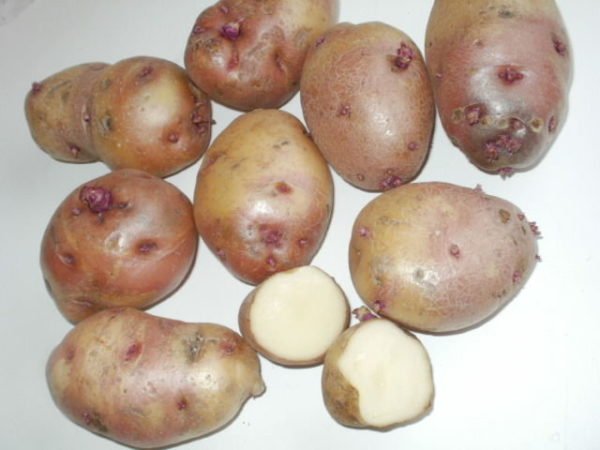

Make sure the tubers are healthy before planting potatoes
Ivan da Marya responds with a large harvest when planting on areas with light fertile land. Can grow in a shaded area, but prefers sunlight throughout the day.
Ivan da Marya can be planted according to the traditional scheme for mid-ripening and late-ripening varieties: 70 cm - between rows, 40 cm - between bushes in a row. You can use any method for this: with a ditch or a comb, under a shoulder blade or in vegetable containers.
By measuring the soil temperature at a depth of 10 cm, you can understand whether it's time to sow potatoes or not. For germination in the soil, 3–8оС degrees are considered optimal.
How to land correctly
Growing delicious fruitful potatoes is the goal of every gardener. So that your efforts are not in vain, you need to pay attention to the standard rules for planting a crop and enjoy the results of your labor in the future.
Site preparation


Before planting, the site must be dug up and fertilized.
The Ivan da Marya variety can grow on all types of soil, but it prefers acidified soils more than others. For this culture, a site is chosen where peas, beans, beets, rye were previously grown. And after cucumbers, tomatoes, cabbage and carrots, planting is not recommended.
Soil preparation begins in the fall:
- After collecting the previous harvest, the site is cleared of plant debris, weeds, and tops.
- Then 5 kg of humus or 10 kg of manure per 1 m2 are scattered over the garden.
- In the spring, after thawing the soil, the soil is dug up and leveled with a rake.
Planting is carried out when the earth warms up to a temperature of 10 ° C. As a rule, this is the period from the last ten days of April to May.
Tuber preparation
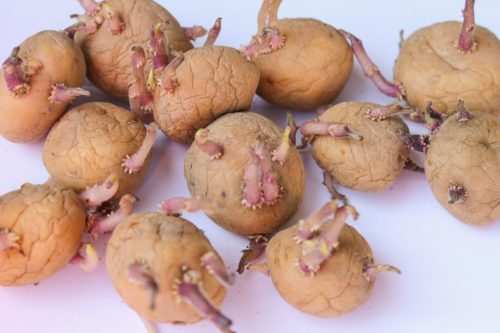

Tubers must be prepared by sprouting or drying.
The tubers must go through the stage of vernalization, that is, germination, which makes it possible to accelerate the maturation of potatoes by 1–2 weeks, as well as to increase the yield. But first you need to select the right material. These should be medium-sized root crops with a diameter of 4–5 cm, without signs of damage.
There are several methods to prepare potatoes for planting:
- In accordance with the first method, the tubers should be spread in one layer in a room with diffused lighting for 2-3 weeks. The temperature is set within the range of 12-15 ° C.
- You can also use the wet germination method. Root crops are folded into boxes or baskets upside down, leaving a distance of 2-3 cm between them. Then sawdust or peat is moistened with water and sprinkled with potatoes. The tubers should be kept in a humid environment throughout the entire germination period, which lasts 15–20 days.
- Drying is an equally effective way. Potatoes are placed in a dry place and kept for 8-10 days at 15-16 ° C.
To protect root crops from possible diseases, a preliminary disinfectant treatment should be carried out. 2 days before planting, they are immersed for 20 minutes in a solution of 10 g of copper sulfate, 50 g of boric acid and 10 liters of water.
If there is a lack of planting material, the roots can be divided into several parts, but each of them should have at least 2 sprouts or buds. Places of cuts are sprinkled with ash, then kept in a shaded room until a crust appears. This method helps to increase the amount of planting material, but it also has some disadvantages. Cut pieces of potatoes are more susceptible to diseases and pests, they are often subject to decay.
Landing methods
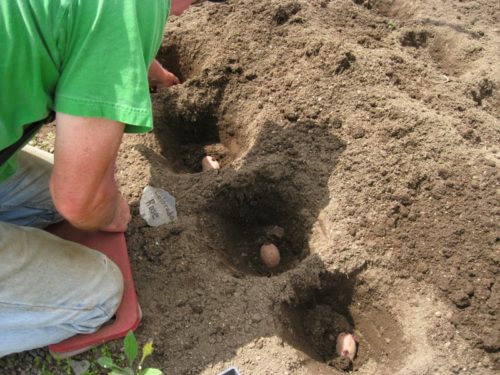

Planting in holes - a classic option for potatoes
The most popular planting method is classic. For potatoes, dig holes 7-10 cm deep at a distance of 30 cm. The rows are placed every 70 cm. Handfuls of wood ash and humus are introduced into the holes, and then watered at the rate of 1-1.5 liters for each. A tuber is placed in the holes and sprinkled with earth.
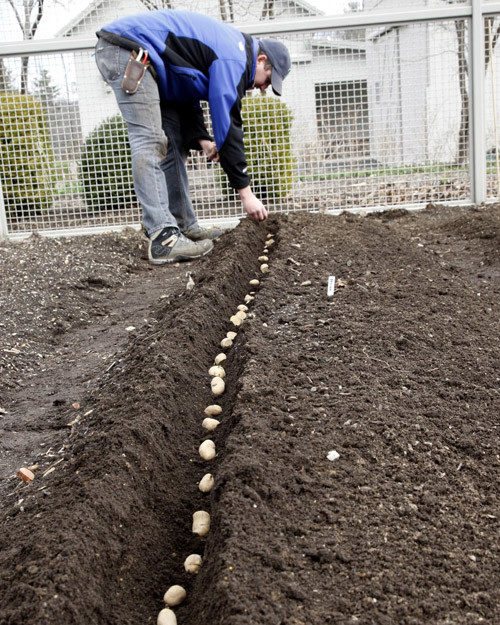

The no-till method allows you to simplify further crop care
Alternative planting methods are gaining popularity today. These include the no-till method, which contributes to the preservation of moisture in the soil, simplifies the care and harvesting of root crops, and reduces the consumption of fertilizers. It runs like this:
- The place chosen for the potatoes is divided into lines 4 m wide, which are placed every 30 cm.
- Next, transverse stripes are drawn on them at a distance of 90 cm.
- Then the tubers are laid, leaving a space of 20 cm between them, and covered with earth, which is dug from the rows.
Preparing tubers for planting
Germination is an important stage for the preparation of tubers. For the appearance of sprouts, seed potatoes are brought into a warm room in about 30 days. Stack the tubers in a maximum of two layers. After a few days, the temperature is reduced to + 10-14 degrees, this is necessary so that the sprouts do not stretch out.
Before planting, the tubers are carefully sorted out, removing specimens with obvious signs of illness or with weak sprouts. Large and medium-sized potatoes are cut into several pieces. This is done about a week before planting in the ground, so that a protective layer has time to form. If there is no time, and you have to cut right before planting, the tubers are dipped with the cut side in wood ash or treated with the preparations "Maxim", "Sinclair", Celest-Top "," Switch ".
Important! Before planting a crop, fresh manure and lime should not be introduced into the ground.
Diseases and pests characteristic of the variety
The variety is very resistant to potato cancer, late blight of tubers and potato tops, leaf-rolling virus and potato nematode. The danger for the variety is the common scab, and from the pests - the Colorado potato beetle.
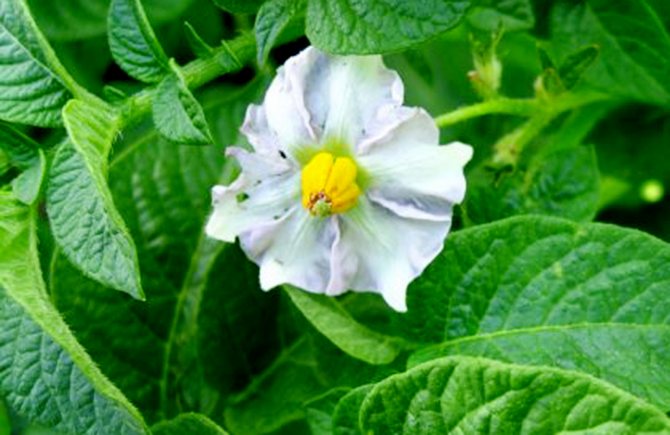

Preventive measures:
- use only healthy seed potatoes;
- discard sprouted potatoes with filamentous sprouts;
- if a diseased bush is found, it should be pulled out and burned;
- destroy emerging pests (Colorado potato beetle, aphids, cicadas), since they are carriers of the disease;
- prevent the dominance of weeds (plants from the Solanaceae family are especially dangerous);
- to process seed potatoes with special means for the prevention of diseases;
- observe crop rotation, avoiding planting potatoes in the same area for more than three years in a row.
If, nevertheless, signs of the disease appear, you need to try to cure the potatoes.
- Double treatment with Agatom-25K (25 g per bucket of water) after closing the tops and two weeks after that helps from late blight on the tops and tubers.
- There is no cure for potato cancer. For prophylaxis, the seed is sprinkled with sulfur (finely ground sulfur powder). Damaged tubers should be destroyed to prevent further infestation.
- Potatoes are protected from leaf curling by applying potash fertilizers.
- Treatment of the soil with the preparation-nematicide Bazamid granulate saves from the potato nematode.It is scattered on the site at the rate of 40 g per 1 m2. If, when planting, put a handful of rotted manure and the same amount of ash in each hole, then the nematode will not appear.
- Treatment of tubers before planting with a solution of boric acid and copper sulfate helps from scab (1 tbsp of each substance is required for a bucket of water). To prevent the disease, the tops are sprayed with Zircon twice a season: the first time after germination, the second before flowering. It is necessary to dilute a glass (250 g) in 10 liters of water. You can use other drugs: Champion, Phytodoctor, Antracol. Their use is carried out according to the instructions for each tool.
From the Colorado potato beetle, there is currently a huge selection of drugs (Iskra, Inta-vir, Bison, Apache, etc.). You need to spray the potatoes before flowering, following all the recommendations for preparing the solution.
To combat harmful insects, you can use methods without the use of chemicals:
- Manual collection of beetles and their larvae, followed by burning of the collected pests (suitable for small areas of potatoes).
- Planting between rows of plants with a pungent odor that repels beetles (marigolds, garlic, calendula).
- Spraying potatoes with infusion of tomato tops or garlic, a mixture of wormwood and ash.
- Pollination of potato tops with ash (10 kg of ash per 1 hundred square meters).
It will not be possible to save a potato bush from cancer, you need to dig it up and destroy it. The potato leaf twisting virus can reduce the yield by up to 50%. spoil more than half of the Phytophthora crop makes potato tubers inedible
Vegetable growers prefer the variety for its unpretentiousness and good resistance to many diseases. Only two ailments are characteristic: scab and Colorado potato beetle.
Scab is a fungal disease that affects the underground part of the plant. The disease manifests itself in gray-black scaly growths on the skin of potatoes. Affected tuber changes taste and is poorly stored.
Due to scab, tubers change taste and are poorly stored
Complex control measures: crop rotation, application of sulfate-containing fertilizers in acidic soil and careful use of manure. Do not fertilize contaminated soil with fresh manure, otherwise it will aggravate the situation. Only compost is used.
Colorado beetle
There is practically no prevention of this pest. The main method of control is the timely treatment with special insecticides according to the instructions. In some cases, it is necessary to treat with chemicals several times per season. With small potato plantings, you can inspect the bushes daily, removing the larvae and leaves with clutches of eggs. If the Colorado potato beetle is not stopped in time, it will destroy all the tops of the bush, and without it, the tubers will not grow.
Colorado potato beetle is able to exterminate the entire ground part of the bush
Diseases
Striped mosaic. The disease occurs during the period of bud development. Necrotic spots appear on the lower leaves. Affected leaves fall off, the plant dies. The affected bushes do not respond to treatment, so they are dug up and destroyed along with the potatoes outside the site.
Twisting virus. In case of disease, the upper side of the leaves turns yellow. Then the lower part acquires a pink tint, the leaf begins to curl along the central vein. The plate becomes brittle. Diseased bushes must be destroyed.
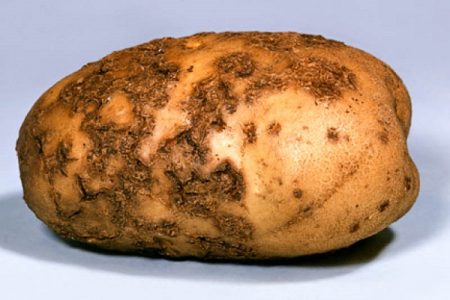

Fomoz... A diseased plant can be easily identified by an elongated spot, which begins on the leaf petiole, and then goes to the stem. The affected parts of the stem die off, the spores of the fungus enter the soil. Putrid dark spots appear on the tubers. For preventive purposes, planting potatoes three weeks after germination are treated with the preparations "Shirlan" or "Thanos".During the flowering of plants, the fungicide "Ridomil Gold MC" is used.
Plant care
For the full development and formation of large volumes of harvest, potatoes require breathable soil. In traditional planting, plant care involves the following steps.
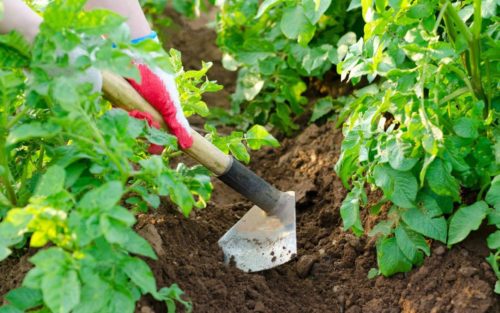

Hilling and loosening allows the potatoes to "breathe" and thrive
5-6 days after planting, they begin to loosen the soil, while removing the weeds. Also, the bushes huddle several times throughout the season. This can be done with a hand hoe or hoe. The work is performed after watering or precipitation.
The number of hillocks depends on the weather conditions. If there is a possibility of frost return, the procedure is carried out immediately when shoots form, which are completely covered with soil. At the initial stage of development, potatoes are quite sensitive to a drop in temperature. At rates from -1 ° C to -3 ° C, the tops acquire a black color.
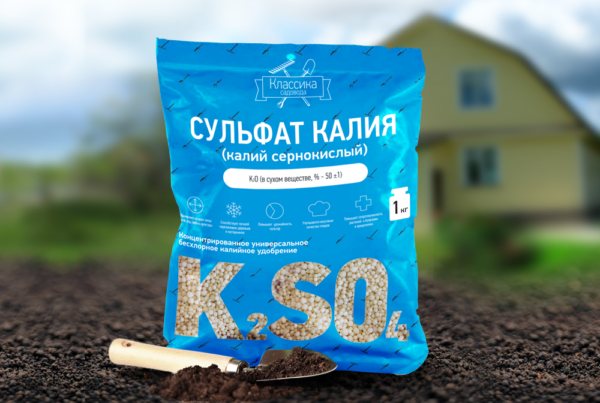

If the onset of frost is not expected, the bushes are spud for the first time when the stems reach 20 cm.At the same time, a mound is formed around the plant, using the soil from the rows for this. After 15–20 days, the procedure is repeated. In order to ensure uniform sun exposure of the stems, they should be parted to the sides.
Fertilization
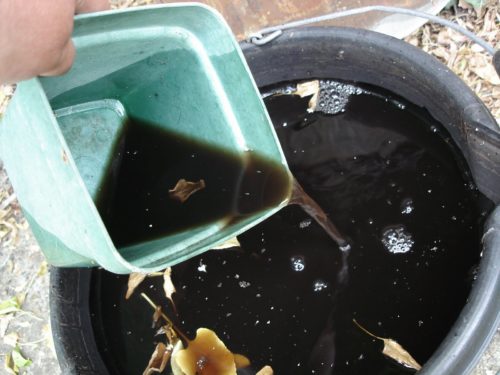

Top dressing is an integral measure for the care of potatoes
For the formation of tubers, the plant spends many nutrients. Therefore, feeding should be given due attention. The compositions are introduced into the grooves dug at a distance of 15 cm from the row.
How to properly care for the variety
Potatoes require proper care, like any plant. The main activities in this regard:
- loosening a few days after planting;
- the first hilling and weeding after the seedlings reach a height of 5-7 cm;
- second hilling during the appearance of the first buds, and not during the flowering period;
- top dressing for prophylactic purposes against late blight with oxyhom and HOM preparations after 2 weeks from the moment of germination;
- the second feeding with fertilizers containing nitrogen and potassium in large quantities, when the height of the bushes reaches 10-12 cm;
- the third feeding with phosphate fertilizers and mullein or chicken droppings at the time of the end of flowering of potatoes;
- watering every 20 days;
- additional drip irrigation in areas with dry weather.
Picture 4 Watering potatoes of this variety requires abundant
For the second feeding, 30 g of ammonium nitrate or urea and 30 g of potassium chloride or potassium salt should be diluted in 10 liters of water. For each bush, you need to spend 1 liter of solution. To prepare the third top dressing, 2 tbsp is taken. tablespoons of superphosphate and 1 tbsp. spoonful of mullein or chicken droppings in 10 liters of water. Each bush requires 0.5 liters of this solution.
Harvesting nuances
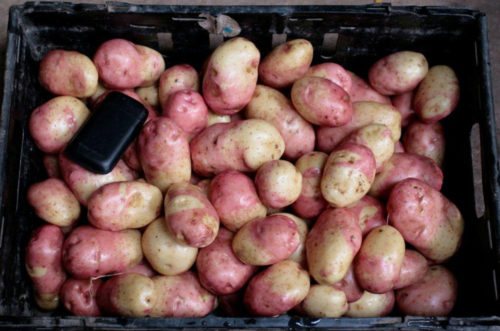

Ivan da Marya potatoes are stored well and for a long time in appropriate conditions
Ripening of root crops lasts 120-150 days after the emergence of sprouts. It is recommended to dig one bush first. If the tubers are at least 3 cm in diameter, you can start harvesting. You should also focus on the tops, which dries up when the potatoes ripen. Only whole tubers are taken for storage. Root crops that have dents, cuts or scratches are laid separately. It is recommended to use them first.
To improve the safety of root crops, they should be sprayed with a solution based on copper sulfate (2 g per 10 water). Tubers of the Ivan-da-Marya variety are distinguished by good keeping quality, which reaches 90%. The crop is stored in a dark, dry and cool place at 2–4 ° C. If the numbers are higher, the potatoes will begin to sprout. And if the temperature is too low, it will lose its taste.
You can store your crops in boxes with ventilation holes. A small space should be left between the container and the wall. This is necessary in order to prevent root decay.For the same purpose, the tubers are shifted with the leaves of elderberry, mountain ash, bitter wormwood or fern. In the absence of boxes, potatoes are poured into the bins with a layer of 1.5 m.
Ivan da Marya tubers are well kept. But for this you need to dig up the potatoes in dry weather and dry them well.
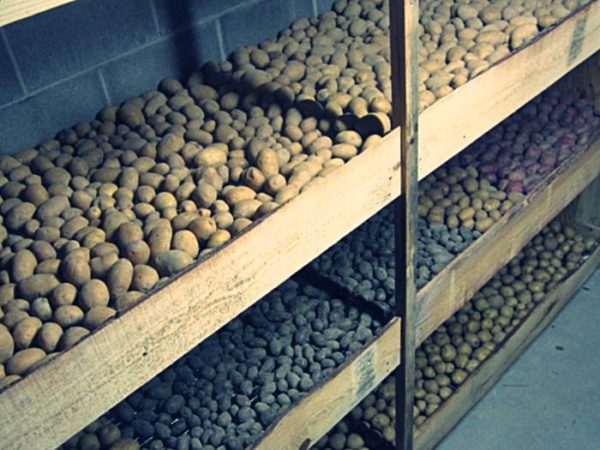

Only healthy whole tubers are laid for storage
For storage, select the marketable potato without damage and signs of disease. Large pieces of soil are carefully peeled. Washing is undesirable, as excessive moisture can lead to rotting of the fruit. The sorted potatoes are placed in baskets or boxes with holes. A layer of newspaper can be placed between the layers of fruit.
The harvest time of the Ivan da Marya variety is early or mid-August. Potatoes in small areas are dug out with a pitchfork so as not to damage the tubers, as is often the case when digging with a shovel.
Potato tubers dug out of the ground must be well dried before storing
Then they are sorted out, immediately sorted by size, and the seed material is separately folded for planting next year. It is necessary to leave the fruits for 1-2 days to dry under a canopy, and then transfer to a permanent storage place. The main condition is moderate humidity, low temperature and lack of soil on the tubers. The fruits must be sorted out 1-2 times during the storage period.
Any potato dish can be prepared from Ivan da Marya
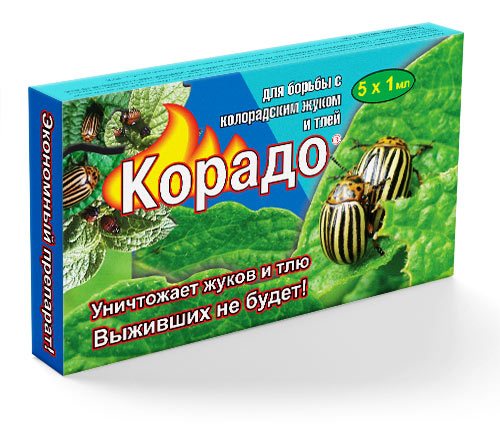

The ripening periods of the varieties are different, and the process of harvesting and storing the crop is no different. As soon as the tops begin to dry out and wither, it means that the roots are ripe. The tops are cut 7-10 days before the start of harvesting. Potatoes are dug with a pitchfork, thus reducing the possibility of technical damage to the tubers.

